Understanding Cats Behaviour: What Is My Cat Saying?
Mysterious and unpredictable, you don’t have to own a Cat to know some general characteristics our feline friends are renowned for. However, you'd be surprised to learn that to the contrary of Cats looking too serious and non-expressive, there's a high chance you could have missed out on some communicative signs from your kitty☺
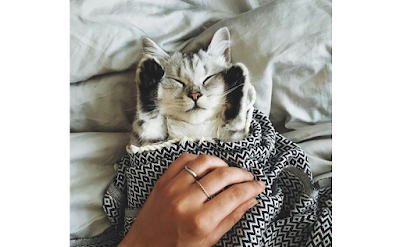 |
| Source |
The initial thought of trying to understand your Pets may be baffling to many and even insane to some— the knowledge in turn results in a fun process and stronger Pet-owner relationship. If you didn't already know, Cats express themselves best through their body language and sounds they
make, Every Kitty is a unique individual in their own ways. With a little time and observation, you’d be able to read your feline companion much better:
Angry Cat Body Language & Sounds
Being as agile, active
and feral as they are, Cats have a myriad of body movements— ones that can tell us a lot about what they’re thinking of while in your presence. Some of which are easily recognizable, for they aren't too far off from common human expressions! Longer observation also teach us to differentiate the sounds that accompany these moods.
1. Angry Cat — It doesn't take a Cat expert to know that this is high time to back off when you see these clear indications of anger and/or fright:
- Straightened Tail
- Standing Hairs
- Snarling Expression
- Flattened-backward Ears
- Hunched Back on Four Feet
Fun Fact #1 Did you know, a Cat fluffs up its hairs in moments of anger, as an all-out attempt to look larger than what’s frightening or threatening them? The bigger the badder, indeed.
Angry Sounds — The sounds that accompanies an angry Cat are usually as follows:
- Straightened Tail
- Standing Hairs
- Snarling Expression
- Flattened-backward Ears
- Hunched Back on Four Feet
Fun Fact #1 Did you know, a Cat fluffs up its hairs in moments of anger, as an all-out attempt to look larger than what’s frightening or threatening them? The bigger the badder, indeed.
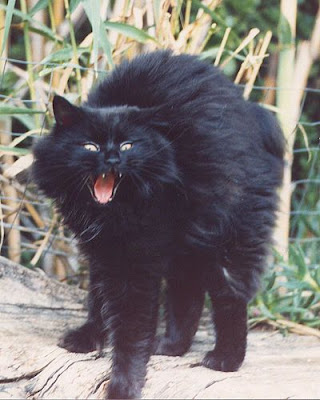 |
| Source |
Hissing and Spitting
Low-toned Growls
Long Yowling
When encountering an angry Cat, it is best advised to not approach them at the moment. This prevents adding onto the tension to this already stressed-out Cat. Observe from a distance, provide personal space and approach only when your Cat isn't displaying any hostile tendencies.
2. Sad Cat — While most Cats are independent, they do so require adequate attention from their owners. Lack of brain stimulation and/or attention makes any Kitty sad. Experts also believe that depression and illness can often be co-related to one another, especially in Pets. Some clear signs include:
- Excessive Sleep
- Avoidance
- Loss Of Appetite
- Poor Self-grooming
The above behaviour can also be displayed together with anger. If such behaviour persists, consult a trusted feline Veterinarian immediately to identify any underlying illness that is possibly causing your Cat discomfort.
Related:
Is My Cat Sick?: How To Tell If Your Cat Is Sick or Sad
- Excessive Sleep
- Avoidance
- Loss Of Appetite
- Poor Self-grooming
The above behaviour can also be displayed together with anger. If such behaviour persists, consult a trusted feline Veterinarian immediately to identify any underlying illness that is possibly causing your Cat discomfort.
Related:
Is My Cat Sick?: How To Tell If Your Cat Is Sick or Sad
Happy Cat Body Language & Sounds
A happy and comfortable Cat that trusts its human companion is often seen displaying more than just one body language and sound. You might already be aware of their love for kneading and hiding in boxes, but what about the following behaviours?
1. The Rolling Cat — A rolling good time is when your Cat trusts you, exposing the least glamorous positions whilst exposing
their vulnerable soft bellies. To avoid any accidental injuries (scratching or biting), only try stroking their bellies if you know they're comfortable with it!
It’s play-time Hoomin! Watch me roll and stretch to my heart’s content.
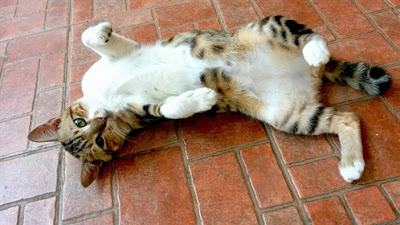 |
| Source |
Before you get too caught up with this sight, know that a Cat's pride holds this behaviour for no longer than a minute, as most owners reported— realizing that they might have revealed too much of themselves, they flip right back up.
2. Rear Flaunting — Heard of the common expression for Cats, jerk-move? Then you must know of how Cat owners sometimes
wake up to their feline companion's butts in their faces. And
while the stench is understandably revolting to many— perhaps you’d feel better knowing that this
is how Cats exchange pleasantries with the ones they deem friends or family!
This is how we greet friends, are you my friend, Hoomin?
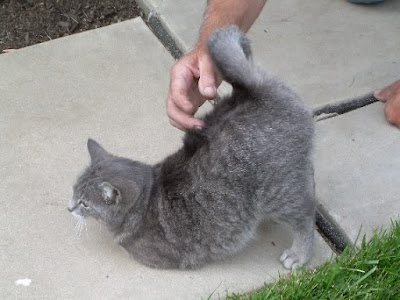 |
| Source |
Fun Fact #2 You can also see this butt-flaunting action when you are giving kitty a good rub down along its back. You know you're giving a sensuous massage and your Cat's loving it!
3. Rubbing Against You — Humans, objects, walls and even fellow felines, Cats love rubbing up against the living and/or inanimate objects as a
form of scent marking. On a good day, some Cats may also adopt the habit of softly head-butting or nuzzling you— actions we personally
find most adorable! Through these actions, the release and imprint of pheromones enables them to recognize their own
scent, thus claiming what's theirs.
You belong to me, and all of these other things too!
 |
| Source |
4. Monorail Cat — Oh Kitty, where have all your legs gone to? Fondly referred to as a Monorail or Hover Cat, here your Cat has its legs tucked in snugly underneath its body. We’d like to think
of this as a Cat loaf, only because it looks exactly like a soft, freshly
baked loaf of bread, right out of the oven.
I like this spot very much, I think I’m gonna cozy up right…here.
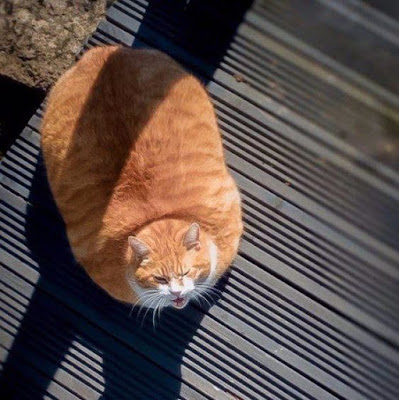 |
| Source |
Happy Sounds — The above body languages are what you can commonly notice from a happy and satisfied Cat, and sounds that follow those actions include purring, soft sweet
meows, and long-low meows to
show happiness, comfort, relaxation, and even as a form of greeting!
Other Cat Behaviours
At times a Cat’s Body
language isn’t necessarily caused by their moods. Instead, they could be indications or signs of other underlying issues. Here are a few
noteworthy Cat behaviours to help you decode the possible problem:
1. Exposed Fecal Matter — Cats love their
privacy and cleanliness when they do their business in their litter trays, and they also
have the habit of covering up their waste and urine with litter. If your Cat
decides to leave its poo uncovered out of the blue over a period of time, you should ascertain that it
isn’t related to a medical problem by making a visit to a trusted feline Veterinarian.
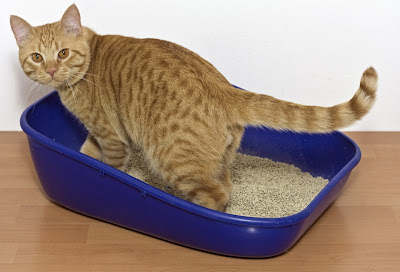 |
| Source |
If your Cat checks out fine, then you ought to ask yourself the following:
Have I done anything to annoy Kitty recently?
Behavioural experts have also related this behvaiour to possible territorial issues between the Cats living within the same household. Retrace any changes in the environment you may have done and give your Cat some time to adapt.
Have I done anything to annoy Kitty recently?
Behavioural experts have also related this behvaiour to possible territorial issues between the Cats living within the same household. Retrace any changes in the environment you may have done and give your Cat some time to adapt.
2. Biting and Chattering — If your Cat isn’t
suffering from anxiety problems, biting and/or chattering behaviour could be viewed as a bad habit. The fact that your Cat could be going through a routined manicure should also be considered. Your feline companion just appreciates a
clean and shiny set of nails.
 |
| Source |
Abruptly biting or
nipping your hand however, is most likely due to
over-stimulation. A Cat tends to get too excited during playtime with you— over-stimulation can build up to an ecstatic nip!
3. Sprinting And Leaping — Being unpredictable as they are, you may have already come across Cats sprinting, jumping and leaping for no apparent reason at the
speed of light. No they do not have a screw loose— it is only natural that they require some moments of free-running time. Call it playtime or exercise, all Cats need quite a bit of both☺
 |
| Source |
Fun Fact #5 Did you know that Cats are true-sprinters at heart, and have the ability to reach 50 km/h if they absolutely feel like doing so?
Want to know more? You might also be interested in:
Want to know more? You might also be interested in:
Your Stories Can Be Heard Too
Do YOU have a story to share? We’d love to share your stories with the world! Your voices are important to us and the Pets community! Our readers are encouraged to share their Pet-related reviews of a place and its services, experiences, even lifestyle tips and tricks to better our Pets lives, on our platform, one paw at a time. Be a part of an educational and informative Pets community because at ThePetsDialogue, your voices could make a huge difference on a global scale.
Write to us at hello@thepetsdialogue.com today!
Our website is a work in progress, however, if you did find our articles interesting please do feel free to share! For more Pet care tips and other Pet-related articles, head to www.thepetsdialogue.com ☺
Disclaimer
This article was written with informational purposes, as you know, we’d love to share our collective research and experiences as fellow Pet owners and lovers. It is not meant to alternate in any way as advice or diagnosis of Professionals.
ThePetsDialogue claims no credit for images posted on this article unless otherwise stated. All rights go to respective owners as stated. If you do not wish for your image(s) to appear here do drop us an e-mail and it will be removed promptly. If you do wish to use any of our original published information, you are welcome to contact us!
This article was written with informational purposes, as you know, we’d love to share our collective research and experiences as fellow Pet owners and lovers. It is not meant to alternate in any way as advice or diagnosis of Professionals.




Some automatic dog food dispensers offer additional features such as portion control, adjustable serving sizes, voice recording capabilities, and smartphone connectivity. These features allow you to customize the feeding schedule and monitor your dog's feeding remotely. Catio ideas
ReplyDelete